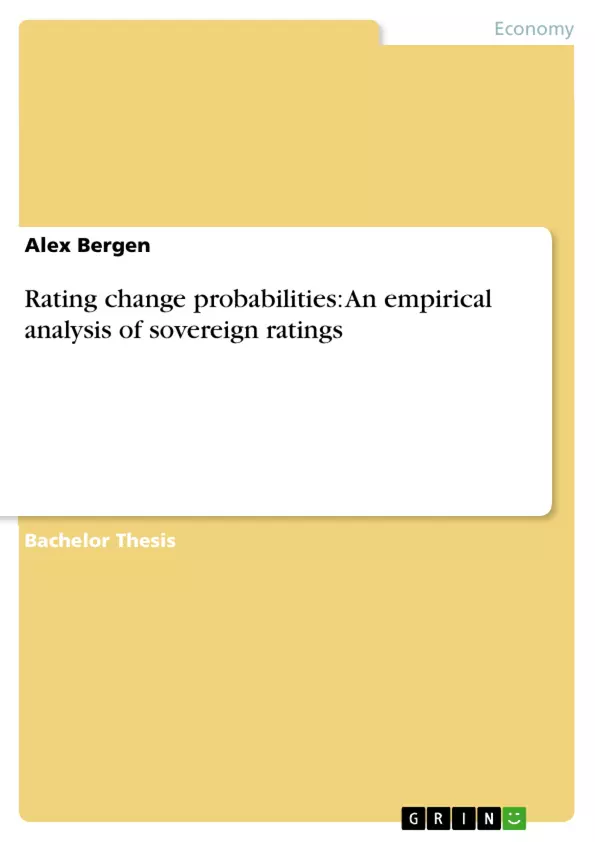In my Bachelor thesis I analyze the determinants of rating changes and the variables'marginal effects on rating change probabilities. Based on my results, I present transition matrices by computing transition probabilities. Furthermore, I analyze subsamples of my data set, conditional on the business cycle and the economic strength of a country, by using interaction effects. I thereby verify whether or how the transition matrices change by including interaction effects.
I apply a latent variable approach, using an ordered probit model, to calculate the effects of different variables on the probabilities of rating changes.
Inhaltsverzeichnis (Table of Contents)
- Introduction
- Previous Literature
- Agencies' rating assessment
- Rating Definitions and Methodology
- Rating Transition Matrices
- Ordered Probit Model
- Mathematical Framework
- Model parameters
- Marginal effects
- Data
- Data summary
- Independent Variables and direction of change
- Choice of Variables
- Estimation
- Simple Ordered Probit Model
- Random Effects Ordered Probit Model
- Marginal Effects
- Predicted Probabilities and Transition matrices
- Predicted Probabilities
- Unconditional Transition Matrices
- Conditional Transition Matrices
- Conclusion
Zielsetzung und Themenschwerpunkte (Objectives and Key Themes)
This Bachelor thesis aims to analyze the determinants of sovereign rating changes and the marginal effects of variables on the probabilities of these changes. The study will use an ordered probit model to calculate transition probabilities and present transition matrices based on these results. Additionally, the thesis will explore subsamples of the data set, conditional on the business cycle and economic strength of a country, using interaction effects to evaluate how these factors influence the transition matrices.
- Determinants of sovereign rating changes
- Marginal effects of variables on rating change probabilities
- Transition probabilities and matrices
- Influence of business cycle and economic strength on rating transitions
- Application of an ordered probit model
Zusammenfassung der Kapitel (Chapter Summaries)
The thesis begins by introducing the importance of sovereign ratings in the context of sovereign debt crises and their impact on countries' borrowing costs. It then discusses the recent examples of Moody's and Standard & Poor's changing their rating outlooks, highlighting the differing perspectives on rating assessments and the need to analyze the factors driving rating changes. The chapter concludes by outlining the thesis's objectives, which include examining the determinants of rating changes, calculating transition probabilities, and analyzing the impact of business cycle and economic strength on these probabilities.
Chapter 2 focuses on the existing literature on sovereign ratings, providing a foundation for the thesis's research. Chapter 3 delves into the rating definitions and methodologies employed by rating agencies, specifically examining the concept of rating transition matrices, which represent the probabilities of rating changes. Chapter 4 introduces the theoretical framework of the ordered probit model, a latent variable approach used to calculate rating change probabilities, and explains the model parameters and marginal effects.
Chapter 5 introduces the data used in the analysis, including a summary of the data, a description of the independent variables considered, and the rationale for the chosen variables. Chapters 6 and 7 discuss the estimation process and the results obtained using the ordered probit model, including simple and random effects models. Chapter 6 also presents the marginal effects of variables on the probabilities of rating changes. Chapter 7 then explores the predicted probabilities and transition matrices, analyzing both unconditional and conditional matrices based on the business cycle and economic strength of countries.
Schlüsselwörter (Keywords)
The primary focus of this thesis lies on the determinants of sovereign rating changes and the impact of various variables on the probability of these changes. The analysis employs an ordered probit model to calculate transition probabilities and generates transition matrices, taking into consideration the influence of business cycle and economic strength. Therefore, key terms include sovereign ratings, rating changes, transition probabilities, ordered probit model, marginal effects, business cycle, economic strength, and interaction effects.
- Quote paper
- Alex Bergen (Author), 2012, Rating change probabilities: An empirical analysis of sovereign ratings, Munich, GRIN Verlag, https://www.grin.com/document/231459



